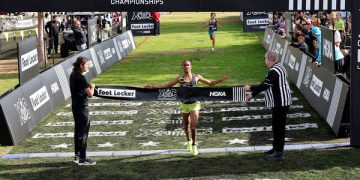This is Lori Shontz’s second article for the Portland stop of the Tracktown Summer series. In it, she provides us a unique view into the meet through the eyes of several of the athletes. Tell us what you thought of the meets, email me at runblogrun@gmail.com.
GRESHAM, Oregon–Normally when sprinter Michael Rodgers travels to a competition, he has to make sure to pack some oatmeal, some ramen noodles. He can rely on food like that–“college-people food,” he said, laughing–when he’s traveling the international track circuit and finds himself, as he often does, in a place where the meat on his plate is kind of a mystery.
So competing Sunday in the Tracktown Summer Series event in Portland, as part of the New York Empire, was a treat for Rodgers. He didn’t have to cross an ocean. He got a per diem, just as when he was back in college, courtesy of Tracktown USA, which also took care of his travel and his hotel. And he traveled without with his children, ages 5 and 2, so he got a terrific night’s sleep.
So, yes, Rodgers is a fan of the Tracktown Summer Series concept.
“We need more meets in the U.S.,” he said. “I’m tired of getting on a plane, eating nasty food like at the other meets. We get to stay home, be in an American hotel, watch American TV. I hope we get more meets like this–we can stay home, and track gets more popular.”
As if all that weren’t enough, Rodgers won the 100 meters in 10.16 and helped his team, the New York Empire, to a team victory in the meet with 86 points, edging the Philadelphia Force by one point and getting bragging rights heading into Thursday’s Summer Series Final in New York City.
The narrow victory resulted in a flurry of Twitter posts from the Empire team members, with 800-meter runner Casmir Loxsom noting that the team has “home-field advantage” on Thursday, and Stephanie Garcia, who won the 3,000 meters in 9 minutes, 1.05 seconds, saying that the team is “going into the final with some momentum.”
Garcia, who finished fourth in the steeplechase at U.S. nationals, missing the world team by 12 seconds after face-planting into the water jump in the preliminaries, was one of many athletes happy to put a less-than-optimum performance at nationals behind her with another meet the next week.
“After you have a heartbreak at U.S. nationals, you can do two things,” she said. “You can go home and hide under your blankets, or you can go back out there and try again. And my career’s proven that I always go back out there and try again.”
Other winners Sunday afternoon at Mount Hood Community College were Barbara Pierre in the 100 meters (11.14, wind-aided), Drew Windle in the 800 (1:46.21), Phyllis Francis in the 400 meters (50.65), Ben Blankenship in the 1,500 (3:37.424), Omar Craddock in the triple jump (55 feet, 5 1/2 inches), and Inka McPherson in the high jump (6-2 3/4).
Michelle Carter and Ryan Whiting combined for a win in the mixed shot put relay event, which started the meet and drew a solid core of fans to watch the event while nothing else was going on.
“You know, we love going to Europe,” Garcia said. “We love going to the Diamond Leagues. But those are tough. Doing something like this for all levels–there are people out here who are American record holders and people who just made it into USAs this year–it’s so exciting. I love that Tracktown has created this opportunity.”
Tracktown USA estimated the attendance at 1,300, and the fans got an up-close-and-personal experience. Triple jumpers wandered around at Mt. Hood Community College before they competed. Windle’s dog, Polly, attended the meet in a Portland Pulse t-shirt. Fans posed with shot putters in the circle after that event. And the athletes ran with little kids in a “half-lap” event after the final official event, forming a tunnel for the finishers and giving high-fives.
“It’s real fun,” Rodgers said. “It’s like college days. I miss college.”
And what he misses mostly–besides the per diem, he said, laughing–is having teammates.
“It just gets you pumped up,” Rodgers said. “It also puts pressure on you too, because your team needs points. Usually it’s individual–nobody’s cheering for you. Everybody wants you to fail. Now you got people out here who want you to succeed–it’s a lot easier.”
And, the athletes agree: It’s more fun.
“Most of the people you see around the circuit, you cheer for them, but they’re your competitors or a competing brand,” Garcia said. “I love being able to go out there and cheer for the 800 guys, the 100 meters, the triple jumpers. It’s so great.”





















